40th anniversary of the local historic preservation law in DC as an opportunity for assessment
The difference between federal and local laws. One of the things that's often frustrating in talking about historic preservation is the dichotomy between promotion and protection.
By that I mean that people argue that a building or district is protected by being listed on the "National Register of Historic Places," run by the National Park Service/Department of Interior as one of the elements that derived from the 1966 National Historic Preservation Act.
The NHPA was in part a reaction to urban freeways and urban renewal destroying extant places. The law is only relevant to "federal undertakings" like building a road or transit system, funding urban renewal, etc.
Local actions by a local or state government are not covered, unless funding for the project includes federal funds. Actions by developers and property owners are not covered at all, because they aren't federal undertakings.
To have the most protection, you need local laws. Some states preclude this (for example in the past few years, the Utah Legislature passed laws making it impossible for the City of Salt Lake to create more historic districts), but that's pretty rare.
I've written about this in terms of "remedies," with laws you have remedies or a course of action when buildings are threatened, without remedies you can only hope you will be successful at persuading a property owner to save a building when they've already decided not to.
-- "Preservation advocacy may be more successful when companies are vulnerable to public pressure: Baltimore County vs. Fairfax County, Virginia vs. Robbinsdale, Minnesota," 2016
-- "The real historic preservation lesson from DC's Uptown Theater is about legal protections and remedies, not activism," 2017
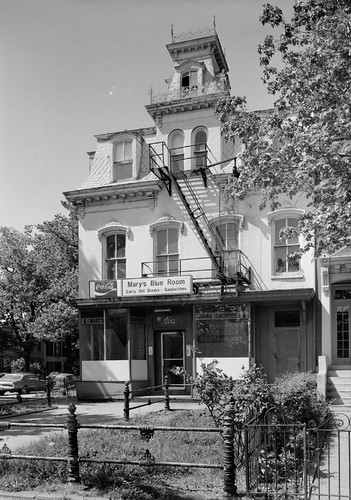 Mary's Blue Room was demolished in the early 1970s by the Capitol Hill Baptist Church for a parking lot. Ironically, about 30 years later, they sold this and adjoining lots for redevelopment as large rowhouses.
Mary's Blue Room was demolished in the early 1970s by the Capitol Hill Baptist Church for a parking lot. Ironically, about 30 years later, they sold this and adjoining lots for redevelopment as large rowhouses.DC passed its own law in 1978, which took effect in 1979. (DC functions as a state as far as historic preservation is concerned. There are also some other wrinkles with regard to federal properties and Georgetown because of separate federal laws.)
-- Historic Landmark and Historic District Protection Act of 1978, Washington, DC
There were a number of reasons behind the law, but one was the recognition that despite many neighborhoods like Capitol Hill being on "the National Register" there were many instances where buildings or the neighborhood's architectural integrity were threatened by non-federal undertakings.
2019 is the 40th Anniversary of the DC Historic Landmarks Act. Last Fall, DC Preservation League sponsored a conference, and actually was quite good, when my expectations were low.
At the conference, in response to a point I made, DCPL director Rebecca Miller made an interesting observation, that since 2019 is the 40th anniversary of the local landmarks and preservation law taking effect, it would be worthwhile to do an assessment of the law/state of preservation/gaps in the city.
DC's local preservation law is one of the strongest in the nation. The reality is that DC's local law is arguably the strongest in the country. The decision to designate a building or historic district is not subject (in normal circumstances--there is a process of judicial review if the property owner continues to object) to extraordinary review or final approval by either the Executive or Legislative Branches. Neither the Executive nor the Legislative Branches has the legal authority to remove the historic designation of a building, site or district.
Non-property owners can submit nominations for buildings they don't own, providing they have standing as a preservation-related group. Religious buildings are not exempt from the law.
That being said, while protections are significant for buildings and districts that are designated, there are virtually zero protections for buildings that aren't designated.
And it is almost impossible to stop an undesignated building from being demolished or altered in significant and damaging ways unless as an individual building (not a contributing structure in a historic district) it meets the criteria for designation..
Safeway asks for a determination that a building is not historic. On the HistoricWashington e-list, someone sent an email about how the company that owns Safeway and specifically the Safeway on MacArthur Boulevard in the Palisades neighborhood, has submitted a nomination for the building, but asking for a determination that the building isn't worthy of designation, which is "unprecedented".
-- Submission by Safeway for the property at 4865 MacArthur Boulevard, Palisades, DC
That reminded me of the 40th anniversary of the local law and provides the excuse for summarizing my thoughts about the state of historic preservation in the city.
Gaps in DC's historic preservation practice
1. Lack of a systematic and complete inventory of buildings. With regard to this specific point, about the owners of the Safeway in the Palisades seeking a determination that the building isn't a historic resource, in other cities, there has been a more systematic process for inventorying "all buildings" for their potential to be listed as a historic resource, either individually or as a contributing building to a historic district.
Not having such an inventory makes it hard for property owners to determine the potential for historic status of an undesignated building.
That doesn't mean those cities have either completed the inventories, or acted on the recommendations. (In fact, DC doesn't have a process for reacting to a Section 106 review that recommends whether or not properties/districts should be protected as part of a process that is a federal undertaking.)
When I first got involved in preservation in the early 2000s, a couple years into my involvement, there was a scintillating series of articles in the Chicago Tribune, called Squandered Heritage, about the demolition of buildings there that in preliminary city wide inventory processes had been determined to be eligible for designation.
The print sections were pretty amazing. Usually each article had about two full pages on the inside, with many color photographs (these links are text only).
-- "Squandered Heritage Part 1: Search and Destroy"
-- "Squandered Heritage Part 2: Demolition Machine"
-- "Squandered Heritage Part 3: Alternatives"
 2. New construction as decidedly different or as part of the neighborhood as an "ensemble". Professor Stephen Semes, author of The Future of the Past: A Conservation Ethic for Architecture, Urbanism, and Historic Preservation argues that the concept of newly constructed buildings being decidedly new in style--architecture of its time--clashes with the predominate "era of architectural significance" of historic districts--architecture of its place--as an ensemble and that this guidance is damaging to historic districts as intact representations.
2. New construction as decidedly different or as part of the neighborhood as an "ensemble". Professor Stephen Semes, author of The Future of the Past: A Conservation Ethic for Architecture, Urbanism, and Historic Preservation argues that the concept of newly constructed buildings being decidedly new in style--architecture of its time--clashes with the predominate "era of architectural significance" of historic districts--architecture of its place--as an ensemble and that this guidance is damaging to historic districts as intact representations.From a review of the book in Traditional Building Magazine:
This book rejects the Modernist ideology that is embedded in current preservation philosophy, which has led to government promotion of architecturally dissonant construction in historic places. Instead, Semes argues persuasively that visual wholeness and architectural continuity of historic areas should be the paramount design imperative. In many historic settings, new traditional architecture provides the best route to harmony with existing building fabric, and Semes calls for rethinking preservation policies that have blocked the use of compatibly styled traditional design.3. Treat the entire city as a "heritage area" from the standpoint of the design management of the built environment, using the concept of the cultural landscape, so that all buildings would have some basic design review and demolition protections, regardless of whether or not they are listed either individually or as part of an existing historic district.
Otherwise, so many buildings and neighborhoods are unprotected now, and likelihood of protection is slim, e.g., our 1929 bungalow is quite intact, but there is no chance our neighborhood would ever become a historic district, or that a typical building of its type (e.g., bungalow, Craftsman style rowhouse, Italianate frame or rowhouse, Queen Anne rowhouse, etc.) would be able to be designated individually as opposed to being a contributing structure in a neighborhood historic district, except in exceptional circumstances.
In the US, there are two types of heritage areas, either state or federally designated. I am not arguing that we need to create a formal heritage area in DC. Rather we can use that framework, that is thinking about the city in its entirety as a cultural landscape, for managing the city's built environment.
Locally, Maryland has a system of state heritage areas, although they have limited additional protections concerning designation and protection and are more focused on tourism development.
4. Lack of architectural integrity means some buildings shouldn't be designated. When I first got involved, I had less tacit knowledge and so the concept of architectural integrity was somewhat elusive to me. The case of a building on H Street made it clearer. The building
"was old" but while it dated to the 1800s, sometime in the 1930s it had been subjected to an update of its facade as a kind of "Colonial Revival" which until that time didn't have antecedents in DC's history of its built environment. The loss of the building's architectural integrity made it impossible to "save" the building individually in terms of the historic preservation guidelines/regulation because it didn't meet the standards embodied in the decision-making criteria.
5. Are ordinary commercial buildings worthy of protection? While originally I thought it was important to save every building, the reality is that a box of a building, even if dating to the 1920s or earlier, isn't necessarily noteworthy, and the urban planning side of me understands the argument of "sacrificing" such buildings to more intensely developed projects.
This is the primary issue wrt the Safeway in the Palisades.
OTOH, Safeway had a distinctive building type dating to the 1950s and 1960s that was constructed in DC and across country. But now in DC, buildings of this design are no longer in their portfolio, having been abandoned to other uses or demolished.

This store was in Wheaton, Maryland, but is of the same design.
6. Special design review considerations for Avenues (and Circles). The Comprehensive Land Use Plan says that the avenues are special, but there are no special design review or architectural design requirements for these streets, unless a particular portion is part of a historic district. New buildings tend to be designed in ignorance of the qualities of the historic architecture on these streets. This is true too in the sub-ordinary design of new buildings on triangular lots along avenues and circles.
-- "An argument for the aesthetic quality of the ensemble: special design guidelines are required for DC's avenues," 2015
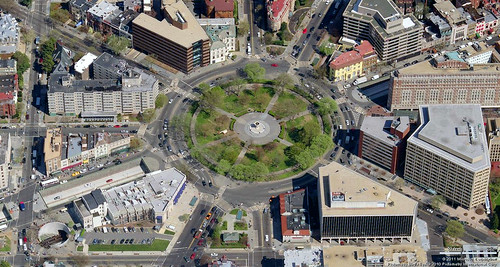
Dupont Circle.
7. The ouevre of an architect or style overall versus the presence of buildings in DC in making a determination of historicity. In terms of both the Mies van der Rohe designed MLK Library and the now no longer extant brutalist Church of Christ Scientist building on 16th Street NW, is it justifiable to say that yes, these buildings are examples of the work of a particular architect or style, but no these particular examples do not rise to the level of being worthy of designation in DC, even though these may be some of or the only examples of this kind in DC?
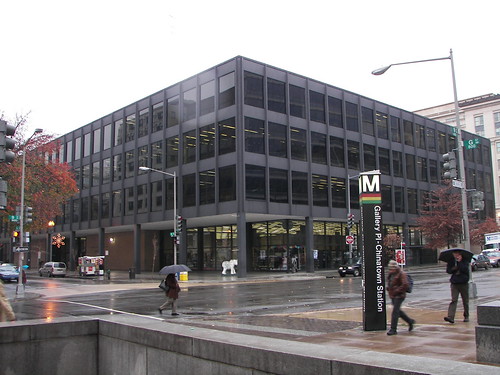
Martin Luther King Jr. Library, DC.
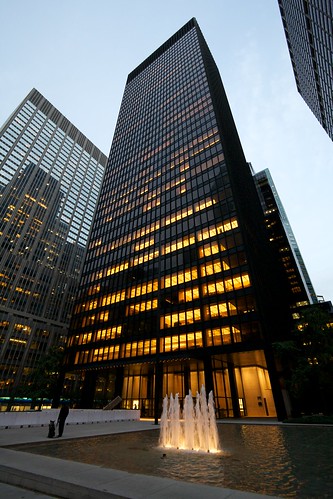
Seagram Building, Manhattan, New York City.
In terms of brutalism, this is relevant to the FBI HQ, maybe the HUD HQ, theoretically the Reeves Building, were nominations submitted for those buildings. In any case, Section 106 reviews (the review process under the NHPA concerning "federal undertakings") will happen wrt the FBI and HUD buildings if changes to those sites are proposed.
8. Historic district review committees. In other cities, each historic district tends to a have a review committee, with members meeting criteria for eligibility for membership similar to that of DC's HPRB.
In DC, we don't have a comparable structure. We do have the Advisory Neighborhood Commission structure where various matters are referred as a matter of course, and some neighborhood historic preservation groups, such as Capitol Hill Restoration Society, have standing committees that weigh in on proposed changes to buildings and districts.
This process often doesn't work that well, in part because there is little substantive training made available to nonprofessionals concerning historic preservation. This is a particular problem with ANCs.
I myself took the "Design" training from the Main Street program four times, which helped quite a bit.
HPO publishes a number of fine materials on various relevant topics. CHRS published a bunch of good topic-specific newsletters, many groups have guidelines publications (like Mount Pleasant), and HPO has been producing guidelines documents with each newly created district. And back in the 1970s, DC published guidebooks for the LeDroit Park and Anacostia districts.
But there needs to be a workshop series too, to help people put this all together. Sometimes reading isn't enough...
But besides the need for a training infrastructure, perhaps a more formal historic district review process should be created for each historic district. It could be done in conjunction with ANCs, but with a knowledge requirement in line with the federal requirements for certification of such bodies as part of the historic preservation review process.
While I don't know for certain, I presume this had been a two-story Italianate style frame building that has been added to in a way that is stylistically inappropriate. However, there are examples of taller Italianate rowhouse buildings that could have been referenced to make the addition more appropriate in terms of architectural design.
9. The dilemma of popups. Popups are the addition of one or more additional stories to a building, usually a rowhouse, that had been originally constructed as a two-story building. Most efforts are discordant.
On the other hand, there is the property owner interest of adding more space, and the community interest of adding more dwelling units in a market where demand for living in the city greatly exceeds the supply of housing.
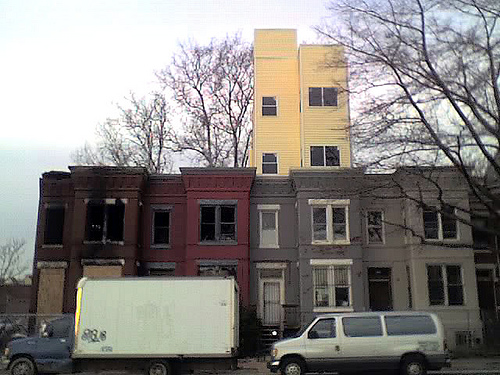
Rather than ban the process altogether, I do believe it would be possible by the creation of the equivalent of a pattern book ("History of the Pattern Book," City of Roanoke; "The Institution of Residential Investment in Seventeenth-Century London," Business History Review), to generate much higher quality outcomes.
10. Lack of support for historic preservation in the context of property rights and the ability of the city to grow. I argue that preservation "saved" DC during the many decades when the city was shrinking in population and residential choice trends did not favor urban living. Preservationists stabilized neighborhoods and "kept them up" and then starting around 2000, attitudes and preferences changed and an increasingly number of people wanted to live in the city.
But even though preservation saved the city, many people resent the review requirements that it entails, and it has been difficult to create new historic districts in the face of changing federal and local laws and political sentiments.
I also argue that this is more difficult because outside of sustainability arguments, preservation as a movement was more focused on urban stabilization and now that DC (and many other cities) have the opportunity to grow, a somewhat reflexive opposition to change doesn't help position the preservation movement or argument for the 21st century.
11. People still have a hard time understanding the concept of a neighborhood historic district. While most people get the idea of saving buildings that are high art or particularly significant in history, like Mount Vernon, George Washington's plantation, or the Empire State Building, they have a hard time understanding "ordinary preservation," specifically residential neighborhoods, because the buildings don't rise to that level of historical importance.
More resources need to be directed to explaining why this type of preservation is important, why buildings are neighborhoods are important historically as a record and as an explanation for particular periods in society in terms of local, regional, national, international, social, economic, and other conditions.
=====
How I got involved in historic preservation. (1) I appreciated the aesthetic qualities of historic architecture, especially the vernacular architecture typical of DC's rowhouse neighborhoods in the core.
(2) I came to believe that historic preservation tends to be the most successful strategy for improving neighborhoods and cities over long periods of time.
Labels: cultural landscape, historic preservation, urban design/placemaking, urban planning, urban revitalization










0 Comments:
Post a Comment
<< Home